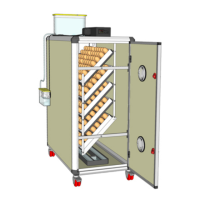6
During incubation embryos produce carbon dioxide. Ventilation is required to
remove carbon dioxide and maintain the correct oxygen levels.
Ventilation is supplied automatically with a fan and adjustable air holes.
Air holes are adjusted by turning the vent to increase/decrease the amount of air
in/out. The amount of ventilation required will depend on egg size and quantity.
Caution! Never close air holes.
Caution! Always keep air holes fully open during hatching period.
Caution! Never breed animals in your incubation room.
Caution! Be sure incubation room is well ventilated.
Caution! Do not let room temperature go below 59
°
F (15
°
C) or above 86
°
F (30
°
C).
Caution! Do not let other animals and insects near the incubator.
Caution! Do not let children operate the equipment.
Your incubator must be located indoors. Place your incubator on a flat
surface, away from doors and windows. Ideal distance from any wall
is 1½ ft (50cm). The area must be clean and well ventilated. The
incubator should not be exposed to direct sunlight, water, or high
humidity levels.
Ideal incubation room temperature is 68-77
°
F (20-25
°
C). Wide
temperature variations in the room will negatively affect your incubation
results. Consider using an air conditioner or heater to maintain room
temperature.

